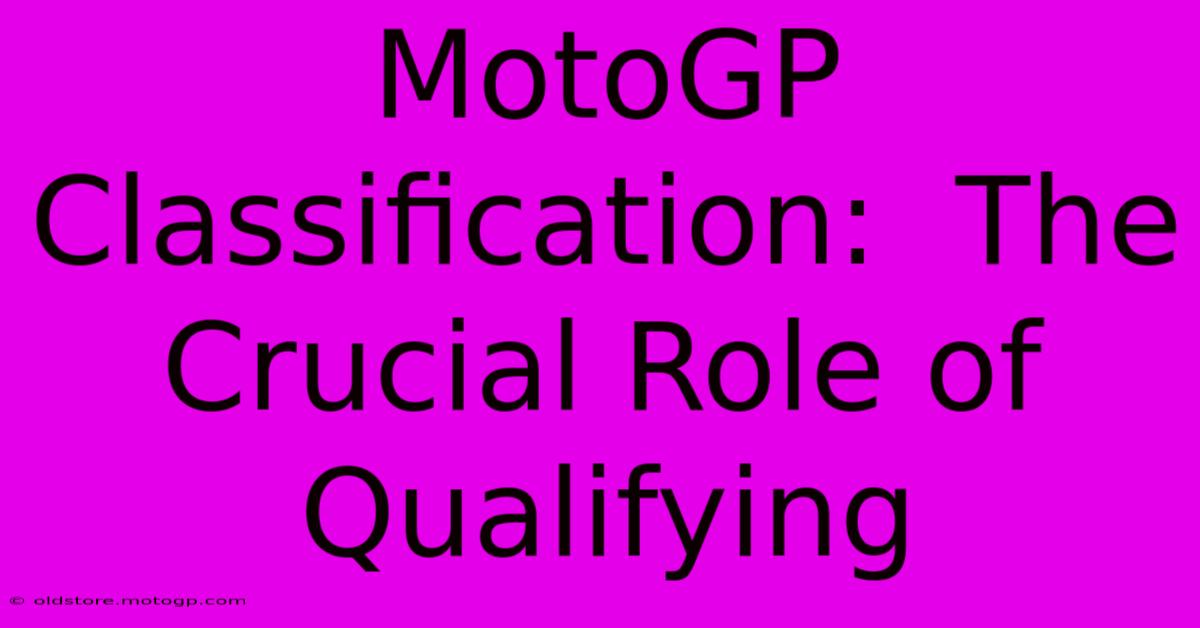MotoGP Classification: The Crucial Role Of Qualifying

Table of Contents
MotoGP Classification: The Crucial Role of Qualifying
MotoGP, the pinnacle of motorcycle racing, is a spectacle of speed, skill, and strategy. While the race itself captivates millions, the preceding qualifying sessions play a crucial role in determining the final outcome. Understanding the intricacies of MotoGP qualifying is key to appreciating the drama and the strategic depth of this exhilarating sport.
The Importance of Grid Position
The starting grid in MotoGP isn't just a formality; it's a significant advantage. A rider starting from pole position (first place on the grid) enjoys a considerable edge, often gaining a crucial lead in the opening laps, before the pack settles into its racing rhythm. This early advantage can be the difference between victory and a mid-pack finish, especially on tracks with limited overtaking opportunities. Conversely, a poor qualifying performance can severely hamper a rider's chances, forcing them to battle through the pack and potentially losing valuable time and positions.
Qualifying Formats: A Breakdown
MotoGP qualifying follows a specific format designed to maximize excitement and fairly determine the starting grid. The process typically involves:
-
Free Practice (FP): These sessions allow riders to test different setups, refine their riding style, and gather crucial data on tire performance and track conditions. FP data provides a baseline for the qualifying sessions.
-
Qualifying 1 (Q1): Riders who fail to secure a spot within the top 10 during the free practice sessions participate in Q1. The top two riders from Q1 then advance to Q2. This ensures that even riders who struggled initially still have a chance to compete for a better grid position.
-
Qualifying 2 (Q2): The top 10 riders from the combined free practice times automatically progress to Q2. This session is fiercely competitive, with riders pushing their machines and themselves to the absolute limit to secure a prime starting position. The fastest rider at the end of Q2 claims pole position.
Strategy and Tactics in Qualifying
Qualifying isn't just about raw speed; it's a strategic battle. Teams meticulously plan their qualifying strategies, considering factors such as:
-
Tire Choice: Selecting the right tires for the qualifying sessions is crucial. A softer compound tire might offer faster lap times but could compromise race performance.
-
Fuel Load: Carrying less fuel during qualifying results in a lighter bike and faster lap times. However, riders need to manage their fuel levels strategically to avoid running out during the session.
-
Slipstream: Riders often utilize the slipstream of another bike to gain a speed advantage, especially on long straights. This requires precise timing and positioning.
-
Track Conditions: Weather, track temperature, and grip levels can significantly impact performance, demanding quick adaptation from riders and teams.
The Impact of Qualifying on Race Strategy
The starting position determined in qualifying heavily influences race strategy. A rider starting at the front can adopt a more conservative approach, focusing on maintaining their position. A rider starting further back, however, needs a more aggressive strategy, likely involving overtaking maneuvers and potentially riskier moves. This adds another layer of complexity and excitement to the MotoGP race itself.
Conclusion: Qualifying – A Critical Element
In conclusion, MotoGP qualifying is far from a mere precursor to the race. It's a high-stakes competition in its own right, demanding precision, strategy, and nerves of steel. The starting grid secured during qualifying significantly impacts the race outcome, shaping the narratives and determining the ultimate victors. Understanding the nuances of this critical phase enhances the appreciation of the thrilling world of MotoGP. Next time you watch a MotoGP race, remember the intense battles fought in qualifying – the foundation upon which the race itself is built.

Thank you for visiting our website wich cover about MotoGP Classification: The Crucial Role Of Qualifying. We hope the information provided has been useful to you. Feel free to contact us if you have any questions or need further assistance. See you next time and dont miss to bookmark.
Featured Posts
-
Cota Qualifying Who Will Rise To The Challenge
Feb 25, 2025
-
Yamaha V4 A Legacy Of Innovation
Feb 25, 2025
-
Moto2 Bike Specs A Riders Guide To Performance
Feb 25, 2025
-
Circuit Of The Americas Unveiling The Concert Lineup
Feb 25, 2025
-
Austin Gp 2025 Where Speed Meets Style
Feb 25, 2025
